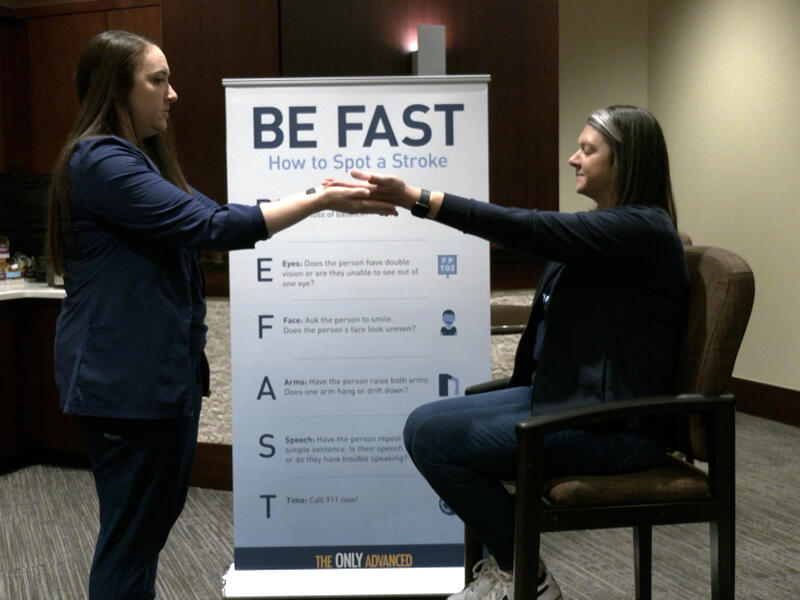Nurses from Sanford Fargo’s stroke program performed a simulated evaluation as part of National Stroke Awareness Month.
The goal: to educate patients and caregivers about the many different ways a stroke may present itself.
“In stroke, all symptoms or signs are sudden,” said Holly Nissen, Sanford Fargo’s stroke program coordinator. “The more that we know coming in and the earlier we know it, the faster we are able to respond and get our teams ready.”
It’s important to BE FAST
Stroke program educator Sue Johnson talked through the most common symptoms, while Nissen demonstrated the abnormal behavior that one might see if someone is having a stroke. Possible signs of stroke can be remembered using the acronym BE FAST.
Balance: “They can come in walking very unsteady, and if you have them do the finger to nose, it can be very uncoordinated. Patients can also have a sudden onset of falling episodes,” said Johnson.
Eyes: “Double vision or blurry vision can happen,” said Johnson. “Or you can have a visual field cut, meaning you can’t see to one side or the other.”
Face: “We have people smile and we say ‘Show the teeth’ so we can get a better assessment of if they have any facial weakness or not,” Johnson said.
Arms: “We have them hold up their arms in front of them. It could be just a slight weakness or they could be totally paralyzed on that side and the arm just drops,” Johnson explained.
Speech: “There’s two parts of speech … we are looking at how clear somebody speaks and also if they’re able to even get the words out. They may not be able to say anything,” Johnson said. “The other part of speech is understanding. Sometimes with stroke, people aren’t able to understand the commands and they will look at you like you’re speaking a foreign language.”
Terrible headache: “There’s a very specific type of hemorrhagic stroke where a blood vessel ruptures in the head. When that happens, they have a very sudden onset of a horrible headache. And most often when they come into the emergency room they say, ‘It’s the worst headache of my life,’” said Johnson.
Time is of the essence
The “T” in BE FAST can also stand for “time.” The faster a stroke is treated, the better chance a patient has of surviving and of retaining motor function as well.
“Any time you notice any signs and symptoms of stroke, it’s really important that you call 911, because that helps us to activate our system in the hospital,” Nissen said. “As you’re coming in, we’re getting information from EMS. Things like your blood pressure, your blood sugar … and that can help us to prepare our team to diagnose and better treat your stroke.”
According to the Centers for Disease Control and Prevention, nearly 800,000 people have a stroke each year. Stroke is the fifth leading cause of death, and it is the leading cause of serious long-term disability in the United States.
Learn more
- Sanford Fargo earns highest level of stroke certification
- 23-year-old survives stroke with quick thinking, response
- Podcast: Stadium announcer loses speech, recovers from stroke
…
Posted In Brain & Spine, Emergency Medicine, Fargo

